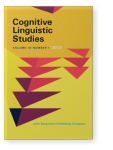Vol. 10:1 (2023) ► pp.99–116
The image schemas of container and source-path-goal in the theory of psychodynamic defense mechanisms
In this article, we evaluated the theory of defense mechanisms from the cognitive linguistics perspective. We chose two basic image schemas of container and path-goal and reviewed three psychodynamic psychotherapy textbooks and two psychology dictionaries to extract passages defining defense mechanisms by one of the selected image schemas. Seventeen defense mechanisms were extracted, categorized, and discussed according to their underlying image schemas. In conclusion, we suggest that the development of the defense mechanisms could be traced back to the early interactions of an infant with the physical environment. Moreover, there might be a relationship between the adaptive levels of the defense mechanisms and the chronological development of image schemas in an infant’s mind, e.g., defenses defined using the image schema of container are usually less adaptive than defenses defined using the image schema of path-goal.
Article outline
- 1.Introduction
- 2.Theoretical framework
- 3.Methodology
- 4.Results
- Defense mechanisms that are conceptualized by the image schema of container
- Defense mechanisms that are defined by image schema of source-path-goal
- 5.Discussion
- 6.Limitations
- Acknowledgements
-
References
